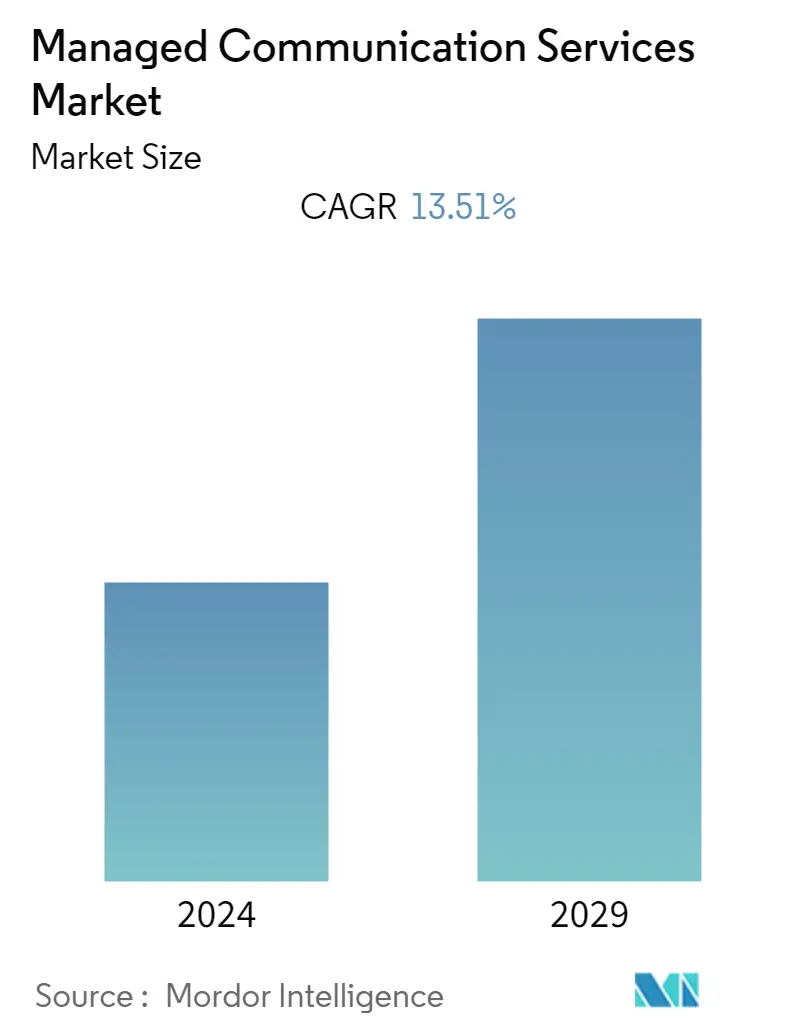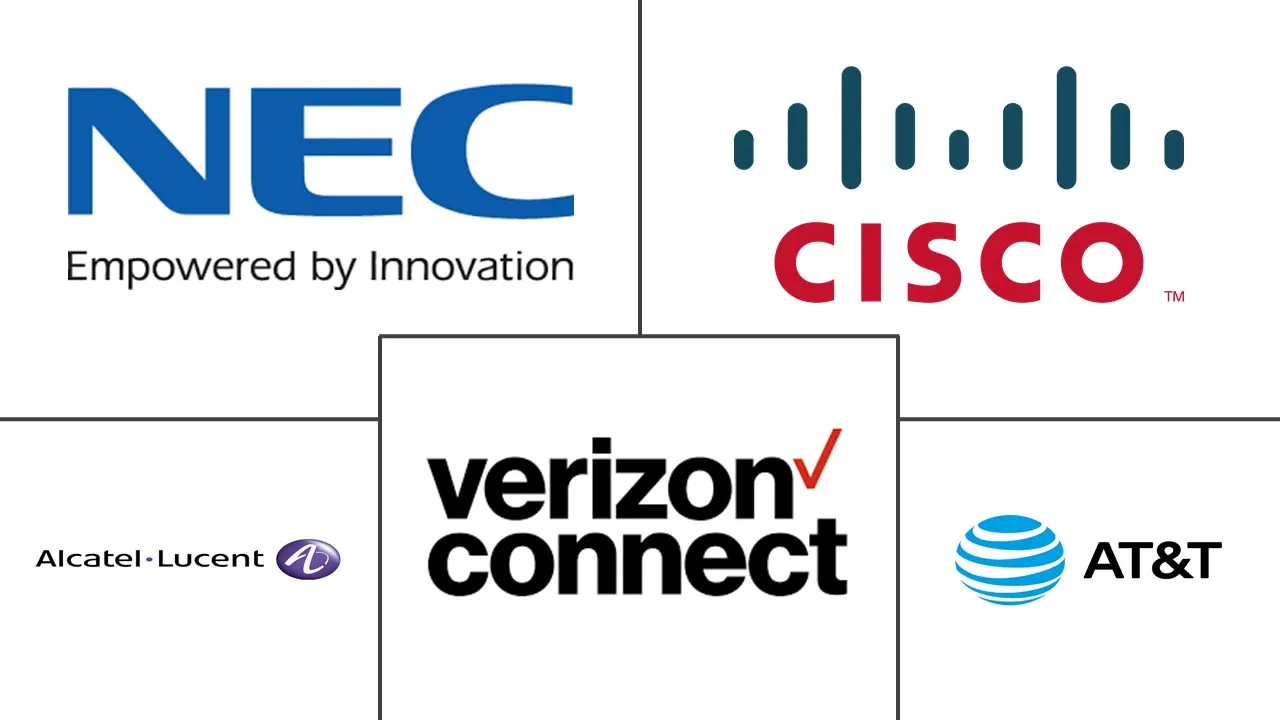Market Size of Managed Communication Services Industry

| Study Period | 2019 - 2029 |
| Base Year For Estimation | 2023 |
| CAGR | 13.51 % |
| Fastest Growing Market | Europe |
| Largest Market | North America |
| Market Concentration | Low |
Major Players
*Disclaimer: Major Players sorted in no particular order |
Managed Communications Services Market Analysis
The managed communication services market is expected to register a CAGR of 13.51% during the forecast period of 2021-2026. Managed service providers can optimize communication systems and offer enormous value at a comparatively low cost. Managed communication services are experiencing increasing demand due to the penetration of technologies, such as mobility, cloud computing, and big data across different industry verticals.
- Unified communications have emerged as a cost-effective solution for businesses across industries, such as healthcare, BFSI, and retail. The unified communications market has historically revolved around individual products. In the past, companies chose individual products to meet particular needs. For example, organizations bought email servers for messaging, team rooms for teamwork, portals for organizational information sharing, and PBX and voicemail for telephony services. Now, customers are making strategic technology decisions to deploy unified communications and collaboration environments based on the capability and integration of the collaboration stack.
- Vendors are undergoing various partnerships, proving to augment the market growth. For instance, In July 2021, Synoptek has announced the purchase of Juxto's direct real-time communications (RTC) business clients and the establishment of a Real-Time Communications Practice combining Synoptek and Juxto capabilities. Synoptek's global experience as an IT integrator, combined with Juxto's North American Carrier-Grade network purpose-built for Teams Voice delivery, provides a voice communication solution that meets and surpasses the most stringent client requirements.
- CenturyLink's new Engage portfolio will provide medium-sized organizations with cloud-based phone and communications services. CenturyLink's Engage solution enables organizations to take advantage of the benefits of cloud-based communications services by leveraging either their own or CenturyLink's connectivity or both. Business clients in all 50 states can use the service right now.
- Remote work mandates caused by COVID-19 are creating an unprecedented opportunity for service providers to promote software-based communications as a key enabler of business continuity and demonstrate the flexibility of communication services in terms of capacity adjustments and services delivery (irrespective of location). This trend is expected to support market growth. Voxbone recently published a report highlighting the virus's impact on its network. According to the study, COVID-19 has pushed a massive increase in demand for cloud communications as businesses look for ways to reduce the threats of things, such as group gatherings and the work commute.
Managed Communications Services Industry Segmentation
Managed communication services cover email, unified communications, and voice over IP (VoIP). Businesses are adopting managed communication services that give them the advantage to perform in the ever-increasing competitive environment. This gives them a zero-cost advantage in the maintenance of technology infrastructure. Managed communication services comprise email, unified communications, and VoIP (voice over IP). It can be deployed on-premise and through the cloud. End-users such as BFSI, Healthcare, retail, etc., are considered in the scope of the study.
| By Deployment Model | |
| On-premise | |
| Cloud |
| By Type | |
| Unified Communication | |
| VoIP | |
| Other Types |
| By End-User | |
| Retail | |
| BFSI | |
| Healthcare | |
| Public Sector | |
| Other End-Users |
| By Geography | |
| North America | |
| Europe | |
| Asia Pacific | |
| Rest of the World |
Managed Communication Services Market Size Summary
The managed communications services market is experiencing significant growth, driven by the increasing demand for optimized communication systems that offer substantial value at a lower cost. The integration of technologies such as mobility, cloud computing, and big data across various industry sectors is propelling this demand. Unified communications have become a cost-effective solution for industries like healthcare, BFSI, and retail, shifting from individual product purchases to strategic deployments of integrated communication and collaboration environments. This transition is supported by partnerships and acquisitions among vendors, enhancing market growth and offering advanced solutions like cloud-based phone services and real-time communication practices.
The market's expansion is further fueled by trends such as remote work mandates, which have highlighted the importance of software-based communications for business continuity. The Bring Your Own Device (BYOD) trend and advancements in VoIP, including AI integration, are also contributing to the market's growth. However, security concerns, particularly with VoIP services, remain a challenge. In Europe, the retail industry's increasing use of unified communications and collaboration solutions is a major growth driver, with significant players expanding their presence in the region. The market is characterized by intense competition, with companies focusing on product launches, research and development, and strategic partnerships to maintain their market position.
Managed Communication Services Market Size - Table of Contents
-
1. MARKET INSIGHTS
-
1.1 Market Overview
-
1.2 Value Chain / Supply Chain Analysis
-
1.3 Industry Attractiveness - Porter's Five Force Analysis
-
1.3.1 Threat of New Entrants
-
1.3.2 Bargaining Power of Buyers
-
1.3.3 Bargaining Power of Suppliers
-
1.3.4 Threat of Substitute Products
-
1.3.5 Intensity of Competitive Rivalry
-
-
1.4 Assessment of COVID-19 Impact on the Industry
-
-
2. MARKET SEGMENTATION
-
2.1 By Deployment Model
-
2.1.1 On-premise
-
2.1.2 Cloud
-
-
2.2 By Type
-
2.2.1 Unified Communication
-
2.2.2 E-mail
-
2.2.3 VoIP
-
2.2.4 Other Types
-
-
2.3 By End-User
-
2.3.1 Retail
-
2.3.2 BFSI
-
2.3.3 Healthcare
-
2.3.4 Public Sector
-
2.3.5 Other End-Users
-
-
2.4 By Geography
-
2.4.1 North America
-
2.4.2 Europe
-
2.4.3 Asia Pacific
-
2.4.4 Rest of the World
-
-
Managed Communication Services Market Size FAQs
What is the current Managed Communication Services Market size?
The Managed Communication Services Market is projected to register a CAGR of 13.51% during the forecast period (2024-2029)
Who are the key players in Managed Communication Services Market?
Cisco Systems, Inc., AT&T Inc., NEC Corporation, Verizon Communications Inc. and Alcatel Lucent Enterprise International are the major companies operating in the Managed Communication Services Market.

